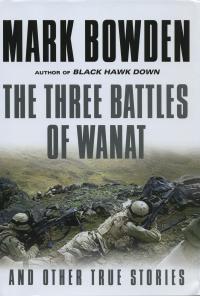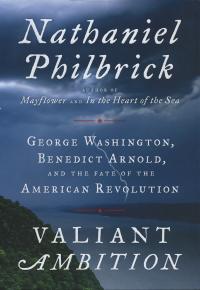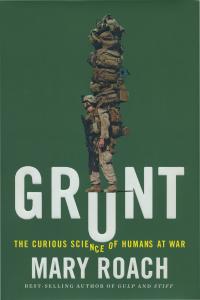July 2016 Book Reviews
July 2016 Book Reviews
Bowden Essays Warrant This Second Look
The Three Battles of Wanat and Other True Stories. Mark Bowden. Atlantic Monthly Press. 496 pages. $27
Buy Now
By Lt. Col. James Jay Carafano
U.S. Army retired
Many know the best-selling author and investigative journalist Mark Bowden for Black Hawk Down, his riveting account of the 1993 Battle of Mogadishu, Somalia. This is not that book. While The Three Battles of Wanat and Other True Stories includes accounts of war, this collection is not a war anthology. Instead, Bowden has assembled some of his best previously published long-form essays covering a variety of topics, from profiles of political figures to great moments in sports. Still, his book, beyond fine prose, has relevance for a military audience.
Bowden leads with his version of the Battle of Wanat, a well-known, disastrous small-unit action that left some of the highest number of U.S. combat deaths from a single engagement during the war in Afghanistan. The essay begins with a workmanlike, blow-by-blow account. Bowden also covers the battle after the battle—the painful controversy over assessing responsibility for the disaster that was catapulted into overdrive when journalists reported on the draft version of the fight analysis by the Combat Studies Institute at Fort Leavenworth, Kan. A series of formal investigations followed that dragged on for years.
Controversies aside, the Battle of Wanat is a classic small-unit action that deserves attention on its own merits. In 2008, an estimated 200 Taliban surrounded and attacked an isolated outpost manned by a platoon from the 173rd Airborne Brigade Combat Team. Over the course of the vicious, brief battle, nine U.S. soldiers were killed and 27 wounded. In addition, four Afghan National Army soldiers were wounded.
The U.S. Army Combat Studies Institute’s report on this battle yields insights on every topic of small-unit combat, from leadership to intelligence preparation of the battlefield to tactics for outpost defense and in the integration of combined arms.
The second essay is an insider’s account of the effort to run down Abu Musab al-Zarqawi. Tracking down high-value targets is one of the many faces of contemporary counterinsurgency warfare. This story centers on the interrogation of a high-value detainee, Abu Haydr. Skillfully gleaning details over a course of interviews that allowed for “mapping Zarqawi’s organization in greater and greater detail,” the intelligence led to a series of raids that rolled up the al-Qaida network and eventually led to taking out its leader.
Bowden’s other war-related essays include an exposé on air-to-air combat; the role of drones in the modern battlespace; and the multiyear effort hunting a faction of Abu Sayyaf, a pseudo-criminal Muslim separatist group in the Philippines that kidnapped three Americans.
All are well-told stories. Of the bunch, “The Killing Machines,” an article first published in 2013, is the best in terms of teasing out all sides of one of the new faces of war: the use of armed unmanned aerial vehicles. Balanced and thoughtful, it provides a thorough look at the contentious debate on the impact of remote killing in modern war.
Together, these essays give a taste of the stuff that is on the menu for the military in the contemporary security environment, but there are items missing from the discussion. The challenges of nuclear confrontation and missile defense are becoming more, not less, relevant. There are also the big three, often overlooked, competitive domains—space, cyberspace and undersea warfare—that ought to be part of any discussion over cooking up recipes for future war.
The book could have benefited from a deeper look at hybrid warfare. This term describes the blending of conventional and subconventional conflict, cyber, and information and black operations as a way of explaining what makes contemporary conflict different from what the armed forces were taught it was like before 9/11. The 2014 Russian intervention in Ukraine is often cited as a real-world application of the hybrid way of war.
Whether the notion of hybrid warfare helps militaries think better than Bowden’s thoughtful essays is a question worth debating. Adversaries combining instruments from across the spectrum of conflict is nothing new. Further, while it is useful to recognize when an enemy is mixing it up, that notion doesn’t necessarily lead to effective counterstrategies. Like the challenges raised in The Three Battles of Wanat, threats need to be met on their own terms.
Lt. Col. James Jay Carafano, USA Ret., a 25-year Army veteran, is a Heritage Foundation vice president in charge of the think tank’s policy research in defense and foreign affairs.
* * *
Benedict Arnold Gets Sympathy in Tour de Force
Valiant Ambition: George Washington, Benedict Arnold, and the Fate of the American Revolution. Nathaniel Philbrick. Viking Press. 448 pages. $30
Buy Now
By Col. Cole C. Kingseed
U.S. Army retired
The American Revolution was waged on two fronts: the war against Great Britain, and the civil war that was so widespread and destructive that the incipient U.S. was nearly destroyed before Gen. George Washington compelled Gen. Charles Cornwallis to surrender his army at Yorktown.
Now comes Nathaniel Philbrick’s Valiant Ambition: George Washington, Benedict Arnold, and the Fate of the American Revolution.
Philbrick is a best-selling author whose book In the Heart of the Sea won the National Book Award for nonfiction. The central theme of his latest tome is that the most formidable threat to American liberties came not from the British, “but from within.”
Valiant Ambition is less about battles won and lost than it is about a people who lived through one of the most tumultuous and creative periods in American history. At the epicenter of Philbrick’s story is the patriot capital of Philadelphia and what he called the war-ravaged Neutral Ground, where, he writes, neither side held sway and neighbor preyed on neighbor in daily struggles that transformed large swaths of New York and New Jersey into “lawless wastelands.”
Valiant Ambition is also a story of how one of Washington’s greatest generals came to decide that the country he helped found no longer deserved his loyalty. During the first two years of the American Revolution, Brig. Gen. Benedict Arnold proved to be one of the abler tacticians in the Continental service. It was Arnold who served as co-commander of the expedition that captured Fort Ticonderoga in May 1775; who led the ill-fated expedition to Canada in 1775; who denied the British mastery of Lake Champlain in late 1776; and who secured the American victory at Saratoga while Continental Maj. Gen. Horatio Gates sought comfort in his tent.
In examining the personal relationship between Washington and Arnold, Philbrick plows familiar ground first explored by Dave Palmer in his masterful George Washington and Benedict Arnold: A Tale of Two Patriots. Unlike Palmer, however, Philbrick turns a more sympathetic eye toward Arnold. Whereas Washington rose above the petty politics of a dysfunctional Continental Congress and maintained his belief in civilian authority, Philbrick’s Arnold “came to decide that the cause to which he had given almost everything no longer deserved his loyalty.”
To his credit, Philbrick portrays a more balanced assessment than Palmer of Washington’s generalship. Groomed on the field in hit-and-run tactics, Washington was not an adept tactician. British Gens. William Howe and Henry Clinton consistently outgeneraled him, first in the New York campaign in 1776 and then at the Battle of Brandywine outside Philadelphia in September 1777.
“No matter how much Washington aspired to be a great general in the European mold, he was at heart a backwoodsman,” Philbrick writes. Washington’s gifts were more physical and improvisational, and he possessed an extraordinary ability to learn and improve amid some of the most challenging circumstances a commander in chief has ever faced.
Arnold emerges from these pages as Washington’s “dark angel.” If Washington had the strength of character to see the long view, Arnold “lived in the messy and highly emotional moment.” The qualities that made Arnold a superb battlefield commander—his passion and self-confidence—also marked his greatest weaknesses. Washington came to realize, albeit far too late in the revolution, that Arnold’s volatility could be dangerous.
Why did Arnold become traitorous? He was hardly alone in having suffered financially during the war and having been subjected to ridicule by the Continental Congress. Even Maj. Gen. Nathanael Greene, Washington’s quartermaster, “received a 1 percent commission on the transactions in his department that earned him, according to one estimate, a total of $175,000 during the Revolution.”
Unlike many of his fellow officers, however, Arnold was determined to do something about it. “After Congress’s repeated refusals to grant him his proper rank … and after almost losing his left leg to an enemy musket ball” at Saratoga, Arnold “felt justified in taking advantage of whatever economic opportunities that came his way.” Now commanding Philadelphia in the wake of the British evacuation of the city in 1778, “Arnold appears to have decided that after losing both his health and his fortune to his country, he must reclaim, as best he could, what was owed him.”
By reaching out to the British, Arnold discovered that switching sides could be extremely lucrative. Philbrick opines that Arnold “was doing this first and foremost for the money.”
One aspect of Philbrick’s narrative that merits exceptional praise is his prodigious research based on personal accounts, archival sources and official records from both sides of the Atlantic. Numerous and well-placed maps also serve to facilitate the reader’s understanding of the war’s military campaigns. Additionally, nearly 50 pages of explanatory endnotes provide greater clarity of the leaders and principal events that characterized the war in America’s Neutral Ground.
In the final analysis, Valiant Ambition adds to Philbrick’s laurels as one of this country’s premier historians. His account of the middle years of the American Revolution is a tour de force, popular history at its best.
Col. Cole C. Kingseed, USA Ret., Ph.D., a former professor of history at the U.S. Military Academy, is a writer and consultant.
* * *
A Playful Scientific Exploration
Grunt: The Curious Science of Humans at War. Mary Roach. W.W. Norton. 282 pages. $26.95
Buy Now
By Kayla M. Williams
I adored Mary Roach’s earlier nonfiction books, explorations of science topics ranging from digestion to space travel to cadavers. Having seen some painfully uninformed writing about military topics by blissfully uninformed civilians, however, I approached her newest book, Grunt: The Curious Science of Humans at War, with a bit of trepidation.
I needn’t have worried. True to form, she willingly acknowledges her unfamiliarity with the martial world and unabashedly recounts the occasionally bemused responses this garners: When touring a Stryker, she comments to her host about the cup holders and then recognizes “the brief, polite silence” as he is “rendered mute by the fullness of my ignorance. They’re rifle holders.” In another anecdote, she asks to be shot by a paintball, and the Marine who had the honor of complying (of the 15 who volunteered) “can be heard in the background of a researcher’s video going, ‘That was very satisfying,’” after which the researcher deadpans, “It’s almost like he knows you.”
This book is not about the science of military munitions or warfare. Rather, it takes readers through a variety of largely unheralded research efforts intended to make going to and returning from war (or sea) more survivable and less miserable: the science of protective textiles, hearing protection, genital reconstruction, training simulations for medics, diarrhea, flies and maggots, malodorants (think of stink bombs) as nonlethal weapons, shark repellent, sleep deprivation among submariners, and more.
Along the way, Roach documents some of the vast array of befuddling military organizations, titles and equipment names, introducing many that even those who study the military extensively may be unaware of. The Army, for instance, “has enough hook-and-loop fastener concerns to merit an entire Hook and Loop Task Group (a subsubcommittee of the Combat Clothing Utility Subcommittee)” and the WIAMan (Warrior Injury Assessment Manikin); during World War II, there was an official Anthropologist to the President, today there is a Navy Entomology Center of Excellence.
I t contains fascinating tidbits of information: urethras are often rebuilt from cheek tissue, due to its properties of being hairless and moisture-tolerant. It is possible to have sex with an indwelling catheter. Humans can sweat as much as 4.4 pounds an hour. The federal specifications for MRE toilet paper include its required tensile strength (wet and dry), as well as allowable colors and required speed of water absorption. There is a Medicare reimbursement code for maggots and a U.S. government standard bathroom malodor. Human perspiration, urine and blood have not proven interesting to sharks; menstrual blood, however, attracts polar bears—though not black bears (and scientists have actually studied all of this). “By weight, a ballistic missile submarine carries more paperwork than it does people.”
Roach’s sense of humor will resonate with many military readers, for whom laughter is a reliable recourse to the surreal fatalism and banality of combat zones: “Oh, for the titular economy of yesteryear. The Stump Hospital [of the Civil War era] is gone and in its place we have the likes of the Veterans Affairs Center of Excellence for Limb Loss Prevention and Prosthetic Engineering.” Her jokes are often dry and subtle: In testing ingredients for stink bomb scents, Roach reports, U.S. Government Standard Bathroom Malodor “repelled, by and large, everyone, with the exception of one unusually open-minded individual who judged [it] to be a ‘wearable’ scent.”
Roach largely avoids topics that are controversial or politically sensitive. The closest she comes is noting that according to one of the men she interviewed, “a recent ban on cigarettes provoked more clatter” than the integration of women into the U.S. submarine force. She also refrains from passing judgment on the morality of warfare, while admitting how surreal it is to watch submariners conduct a nuclear missile launch simulation (that is, rehearsing for what would be an utter calamity) with calmness, and how heart-rending it is to see the autopsy photos of service members being reviewed by the Armed Forces Medical Examiner System program Feedback to the Field in an effort to capture knowledge that could increase survival rates of others who are injured.
Overall, Grunt is a surprisingly lighthearted look at a variety of fascinating, seldom-explored corners of the science and technology of war. Like her other works, it is not a dry, straightforward march through monotonously precise details.
Rather, Roach skims across an array of topics, pausing to delve deeply—and hilariously—into some of their quirkier aspects. If you’re looking for the history or technical specifications of particular munitions, this book is not for you. If, however, you seek a playful romp through a series of underappreciated aspects of the preparation for conflict and its aftermath, one so funny those sitting near you will glance at you askance when you burst out laughing in public even as you are learning a great number of scientific facts, this is the title for you.
Kayla M. Williams is the author of Love My Rifle More Than You: Young and Female in the U.S. Army and Plenty of Time When We Get Home: Love and Recovery in the Aftermath of War. After spending eight years at the RAND Corp. as a researcher, she is now the director of the VA’s Center for Women Veterans. This review was prepared in her personal capacity; the opinions expressed are her own and do not reflect the views of the VA or the U.S. government.




